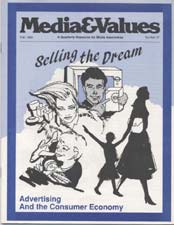WOMEN: Using Female Bodies For Sales and Profit
|
This article originally appeared in Issue# 37
|
Dismembered bodies — thighs, breasts, anus lie strewn across the television screen… exotic women drape themselves over leopard-skin rugs seductively beckoning unknown men...
No, these are not scenes of war's carnage or documentaries of women forced into prostitution. This is commercial advertising, reproduced in the hard-hitting documentary, Killing Us Softly, a 20-minute film that is an excellent resource for use by classes or discussion groups that want to explore the impact of advertising images on society's view of women.
As the pictures flash by and the narration by feminist scholar Jean Kilbourne proceeds, a new view of advertising emerges, that of a multi-billion dollar transnational business which makes its profits off the backs of women.
Killing Us Softly pulls no punches. One cringes with recognition at the visually-substantiated premise that advertising systematically, if not always consciously, uses, abuses and betrays women in its efforts to sell products, lifestyles and dominant values.
In a frequently humorous (and therefore digestible) narrative, Dr. Kilbourne demonstrates how the process of becoming adornments for cars, liquor and men turns women into flawless, wrinkleless, odorless and ageless sex objects fragmented into body pans on display. As women grow older, that "status" is then taken away and they are shown as sexless housewives pathologically obsessed with dirty floors and spotted glasses. The options are few. In the process of living, women are made to feel self-conscious and guilty for being real.
The film often leaves its viewers in silence. Many of my university  students, particularly the women, have a difficult time articulating their new awareness of what had previously been considered a seemingly innocuous but ubiquitous element of their every day environment. For the first time, they take advertising seriously. Once the silence is broken, anger often replaces it - an anger that becomes rage at the sexual objectification of young girls at a time of epidemic child abuse, at the economic and sexual exploitation of women from all races and all ages.
students, particularly the women, have a difficult time articulating their new awareness of what had previously been considered a seemingly innocuous but ubiquitous element of their every day environment. For the first time, they take advertising seriously. Once the silence is broken, anger often replaces it - an anger that becomes rage at the sexual objectification of young girls at a time of epidemic child abuse, at the economic and sexual exploitation of women from all races and all ages.
When using Killing Us Softly in a classroom or discussion group setting, it's important to guard against dismissing its premise as the interesting but "eccentric" interpretation of a single scholar. Supplementary readings (for example Erving Goffman's Gender Advertisements) add legitimacy and support to Kilbourne's approach. It also strengthens the impact of the film's message if viewers examine ads from different media during the following weeks in order to sharpen their own critical skills and internalize an analytic approach to media imagery.
Although it portrays victimization, the film itself is a tool for empowerment. Challenging the dissected images of advertising's females is the first step towards creating whole images of womanhood.



